Maytag MDB6949SDM0, MDB6949SDE0, MDB7949SDE0, MDB7949SDE2, MDB8969SDM3 Owner’s Manual
...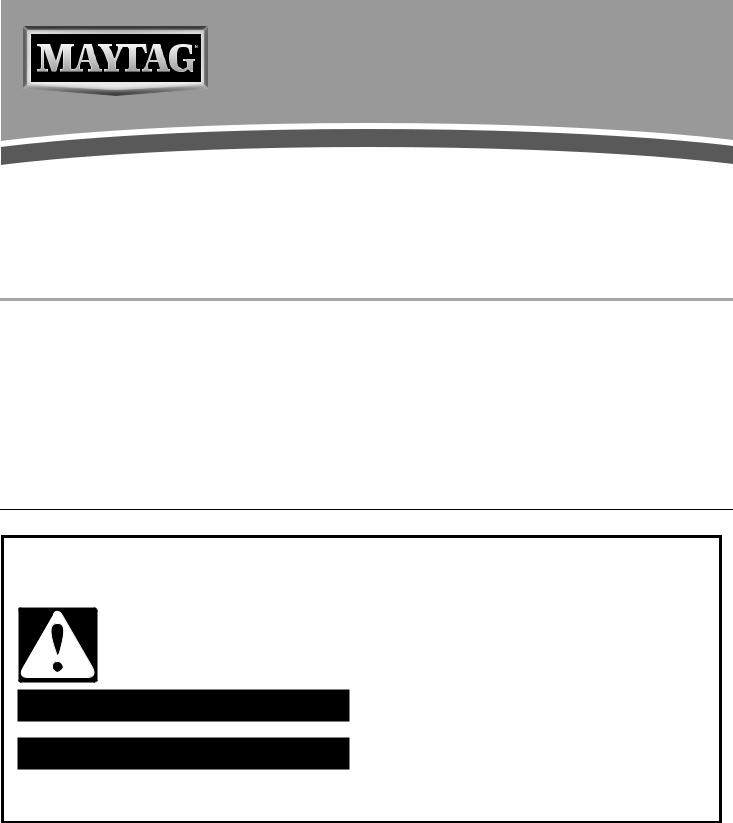
DISHWASHER
USER INSTRUCTIONS
THANK YOU for purchasing this high-quality product. Register your new dishwasher at www.maytag.com. In Canada, visit our website at www.maytag.ca.
For future reference please make a note of your product model and serial numbers. These can be located near the door on the right-hand or left-hand side of the dishwasher interior.
Model Number_________________________________________ |
Serial Number___________________________________________ |
|
Table of Contents |
|
|
DISHWASHER SAFETY ............................................................. |
|
1 |
QUICK STEPS ............................................................................ |
|
3 |
DISHWASHER USE.................................................................... |
|
4 |
CYCLE AND OPTION DESCRIPTIONS .................................... |
7 |
|
DISHWASHER FEEDBACK SECTION...................................... |
9 |
|
DISHWASHER FEATURES........................................................ |
|
9 |
DISHWASHER CARE ............................................................... |
|
11 |
TROUBLESHOOTING .............................................................. |
|
12 |
WARRANTY .............................................................................. |
|
15 |
Dishwasher Safety
Your safety and the safety of others are very important.
We have provided many important safety messages in this manual and on your appliance. Always read and obey all safety messages.
This is the safety alert symbol.
This symbol alerts you to potential hazards that can kill or hurt you and others.
All safety messages will follow the safety alert symbol and either the word “DANGER” or “WARNING.”
These words mean:
 DANGER
DANGER
 WARNING
WARNING
You can be killed or seriously injured if you don't immediately follow instructions.
You can be killed or seriously injured if you don't follow instructions.
All safety messages will tell you what the potential hazard is, tell you how to reduce the chance of injury, and tell you what can happen if the instructions are not followed.
W10599489C
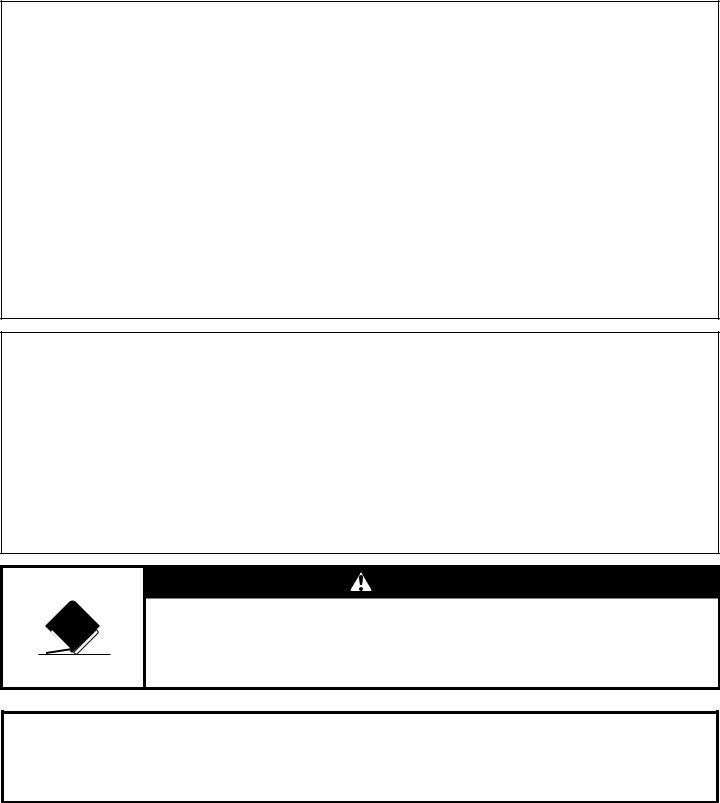
IMPORTANT SAFETY INSTRUCTIONS
WARNING: When using the dishwasher, follow basic precautions, including the following:
■Read all instructions before using the dishwasher.
■Use the dishwasher only for its intended function.
■Use only detergents or rinse agents recommended for use in a dishwasher, and keep them out of the reach of children.
■When loading items to be washed:
1)Locate sharp items so that they are not likely to damage the door seal; and
2)Load sharp knives with the handles up to reduce the risk of cut-type injuries.
■Do not wash plastic items unless they are marked “dishwasher safe” or the equivalent. For plastic items not so marked, check the manufacturer's recommendations.
■Do not touch the heating element during or immediately after use.
■Do not operate the dishwasher unless all enclosure panels are properly in place.
■Do not tamper with controls.
■Do not abuse, sit on, or stand on the door, lid, or dish racks of the dishwasher.
■To reduce the risk of injury, do not allow children to play in or on the dishwasher.
■Under certain conditions, hydrogen gas may be produced in a hot water system that has not been used for two weeks or more. HYDROGEN GAS IS EXPLOSIVE. If the hot water system has not been used for such a period, before using the dishwasher turn on all hot water faucets and let the water flow from each for several minutes. This will release any accumulated hydrogen gas. As the gas is flammable, do not smoke or use an open flame during this time.
■Remove the door or lid to the washing compartment when removing an old dishwasher from service or discarding it.
SAVE THESE INSTRUCTIONS
GROUNDING INSTRUCTIONS
■For a grounded, cord-connected dishwasher:
The dishwasher must be grounded. In the event of a malfunction or breakdown, grounding will reduce the risk of electric shock by providing a path of least resistance for electric current. The dishwasher is equipped with a cord having an equipment-grounding conductor and a grounding plug. The plug must be plugged into an appropriate outlet that is installed and grounded in accordance with all local codes and ordinances.
WARNING: Improper connection of the equipmentgrounding conductor can result in a risk of electric shock.
Check with a qualified electrician or service representative if you are in doubt whether the dishwasher is properly grounded. Do not modify the plug provided with the dishwasher; if it will not fit the outlet, have a proper outlet installed by a qualified electrician.
■For a permanently connected dishwasher:
The dishwasher must be connected to a grounded metal, permanent wiring system, or an equipment-grounding conductor must be run with the circuit conductors and connected to the equipment-grounding terminal or lead on the dishwasher.
SAVE THESE INSTRUCTIONS
WARNING
Tip Over Hazard
Do not use dishwasher until completely installed.
Do not push down on open door.
Doing so can result in serious injury or cuts.
State of California Proposition 65 Warnings:
WARNING: This product contains one or more chemicals known to the State of California to cause cancer.
WARNING: This product contains one or more chemicals known to the State of California to cause birth defects or other reproductive harm.
2

|
Quick Steps |
Prepare and load |
Select a cycle and option (cycles and options vary |
1 dishwasher. |
3 by model). |
C
A B
2 Add detergent and rinse aid.
The full lit display will glow for Wash (A), Dry (B), Lock (C), and Sanitized or Clean.
4 Start dishwasher.
SLIDE
SLIDE 
Dispensers vary by model.
3

Dishwasher Use
STEP 1
Prepare and Load the Dishwasher
IMPORTANT: Remove leftover food, bones, toothpicks, and other hard items from the dishes. Remove labels from containers before washing.
8 Place loading pattern
■Make sure that when the dishwasher door is closed, no items are blocking the detergent dispenser.
■Items should be loaded with soiled surfaces facing down and inward to the spray as shown. This will improve cleaning and drying results.
■Avoid overlapping items like bowls or plates that may trap food.
■Place plastics, small plates, and glasses in the upper rack. Wash only plastic items marked “dishwasher safe.”
■To avoid thumping/clattering noises during operation: Load dishes so they do not touch one another. Make sure lightweight load items are secured in the racks.
■When loading silverware, always place sharp items pointing down. Mix other items
pointing up and some pointing down.
Upper rack |
Lower rack |
10-Place loading pattern
Upper rack |
Lower rack |
12-Place loading pattern
STEP 2
Add Detergent
NOTE: If you do not plan to run a wash cycle soon, run a rinse cycle. Do not use detergent.
■Use automatic dishwasher detergent only. Add powder, liquid, or tablet detergent just before starting a cycle.
■Fresh automatic dishwasher detergent results in better cleaning. Store tightly closed detergent container in a cool, dry place.
Hinged lid style |
Sliding lid style |
SLIDE
Upper rack |
Lower rack |
■ Make sure nothing keeps spray arm(s) from spinning freely. It is important for the water spray to reach all soiled surfaces.
4

Premeasured Detergents
Many detergents now come in several forms (gel packs, tablets, or powder packs).
We recommend that you use high quality tablets or packs for convenience and improved performance. High quality tablets and packs have been proven better than powder, liquid, or gel detergents at reducing filming on dishes. Using tablets and packs
over time will start to reduce or eliminate white film. Also, by using a rinse aid, you can minimize repeat buildup of white film. These forms are suitable for all hardness and soil levels. Always place detergents in the main compartment and slide lid to close.
To close lid |
To open lid |
|
SLIDE |
|
SLIDE |
Place selected detergent in the |
Push OPEN, as shown, |
dispenser. Place finger, as |
and the lid will slide open. |
shown, and slide lid closed. |
|
Press firmly until it clicks. |
|
Powders and Gels
■The amount of detergent to use depends on:
How much soil remains on the items – Heavily soiled loads require more detergent.
The hardness of the water – If you use too little in hard water, dishes won't be clean. If you use too much in soft water, glassware can etch.
Soft to Medium Water (0-6 grains per U.S. gallon) [typical water softener water and some city water]
Medium to Hard Water (7-12 grains per U.S. gallon) [well water and some city water]
■Depending on your water hardness, fill the Main Wash section of the dispenser as shown. Fill the Pre-Wash section to the level shown if needed.
NOTE: Fill amounts shown are for standard powdered detergent. Follow instructions on the package when using gel dishwasher detergents. Premeasured forms are suitable for all hardness and soil levels. Always place premeasured detergents in the main compartment and close the lid.
Hard Water
Soft Water |
Hard Water |
|
Soft Water |
||
|
||
Main Wash |
Pre-Wash |
Add Rinse Aid (dispenser varies by model)
■Your dishwasher is designed to use rinse aid for good drying performance. Without rinse aid, your dishes and dishwasher interior will have excessive moisture. The Heated Dry option will not perform as well without rinse aid.
■Rinse aid keeps water from forming droplets that can dry as spots or streaks. It also improves drying by allowing water to drain off of the dishes after the final rinse.
Rinse aid helps to reduce excess moisture on the dish racks and interior of your dishwasher.
■Check the rinse aid indicator with the door down (varies by model). Add rinse aid when indicator drops to “Add” level.
Full |
|
|
|
Full |
|
|
|
|
Add |
Add |
|
|
|
|
■ Add rinse aid to hinged lid |
|
|
|
|
style dispenser by twisting |
|
|
|
Lock |
the dispenser cap ¼ turn |
|
|
|
|
clockwise to open and lift off. |
|
|
|
|
Pour rinse aid into the |
|
|
|
|
opening until the indicator |
|
|
|
|
level is at “Full.” Replace the |
|
|
|
|
dispenser cap and turn to |
|
|
|
|
“Lock.” Make sure cap is |
|
|
|
¼ trun clockwise to lock |
fully locked. |
|
|
|
|
■ To add rinse aid to sliding lid |
|
|
|
|
style dispenser, open the |
|
|
|
|
rinse dispenser lid by gently |
|
|
|
|
pushing in the center of the |
|
|
|
|
lid with your thumb and |
|
|
|
|
pulling up on the edge. Pour |
|
|
|
OPEN |
rinse aid into the opening |
|
Wash |
|
|
Pre |
|
LIDE |
||
until the dispenser is full. |
|
S |
||
|
|
|||
|
|
|
|
|
Then, close the dispenser |
|
|
|
|
by pushing down gently |
|
|
|
|
on the lid. |
|
|
|
|
NOTE: For most water conditions, the factory setting will give good results. If you have hard water or notice rings or spots, try a higher setting. Turn the arrow adjuster inside the dispenser by either using your fingers or inserting a flat-blade screwdriver into the center of the arrow and turning.
|
- |
- |
6 |
5 |
4 |
|
|
|
- |
|
|
|
|
|
|
|
fill |
|
|
|
|
|
|
max |
|
|
|
|
3 |
||
|
|
|
|
|
|
2 |
|
|
|
|
|
|
|
|
1 |
|
|
|
|
|
|
- |
- |
|
|
|
|
|
|
|
|
|
|
|
|
- |
- |
|
|
|
|
|
|
|
|
|
|
Higher numbers dispense more rinse aid. You should change this setting only a little at a time and then run a few cycles before changing it again because just enough rinse aid is more effective than too much.
5
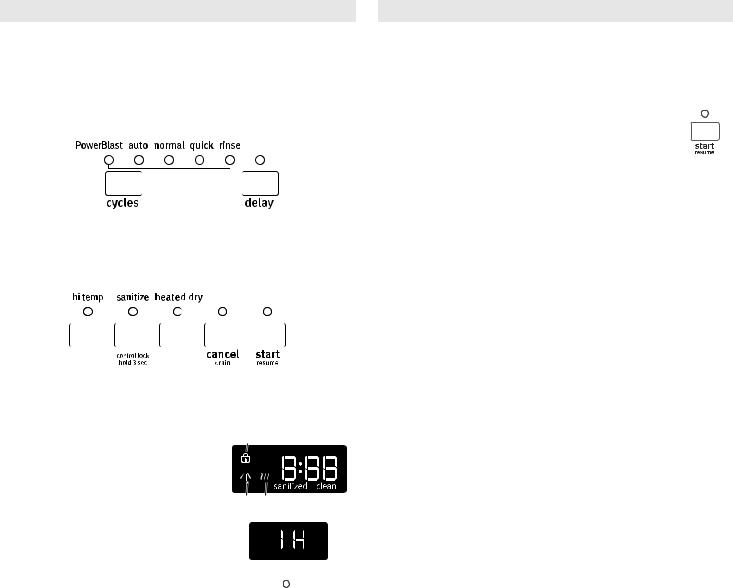
STEP 3
Select a Cycle (cycles vary by model)
Efficient dishwashers run longer to save water and energy, just as driving a car slower saves gas. Cycle times may increase or decrease depending on selections. Estimated cycle times after
calibration are listed in the “Cycle and Options Descriptions” chart in the following section. Select the desired cycle by pressing the CYCLES button. Each time you press the Cycles button it will advance to the next available cycle.
Select Options (options vary by model)
See “Cycle and Option Descriptions” charts in the following section.
You can customize the cycles by pressing the options desired and pressing Start/Resume.
Follow the Progress of the Dishwasher
Depending on the model, progress will be displayed by a fully lit display or by an indicator light on the front panel.
The full lit display will glow for Wash (A), |
C |
|
Dry (B), Lock (C), Sanitized, or Clean. It |
||
|
||
will also show the estimated remaining |
|
|
time for the cycle in hours and minutes. |
|
A B
When delay is selected, the fully lit display will show an “h” for hour and the number of hours to delay.
The indicator light will glow blue for wash, red for dry, or green for cycle complete.
STEP 4
Start or Resume a Cycle
Run hot water at the sink nearest your dishwasher until the water is hot. Turn off water.
For front control models:
■Push door firmly closed. The door latches
automatically. Select the wash cycle and options desired and press START/RESUME or press START/RESUME to repeat the same cycle and options as in the previous wash cycle.
■You can add an item anytime before the main wash starts. Open the door slowly and add the item.
Close the door firmly. Press the START/RESUME button. The cycle resumes automatically at the point of interruption.
For top control models:
■Select the wash cycle and options desired.
■Press the START/RESUME button once and close the door. After a brief pause, the cycle will begin. The door must be closed within 4 seconds after pushing START/RESUME or the lights will flash, and the dishwasher will not begin. Press the START/RESUME button again and shut the door within
4 seconds.
You can add an item anytime before the main wash starts. Open the door slowly and add the item. Press START/RESUME then close the door within 4 seconds.
6
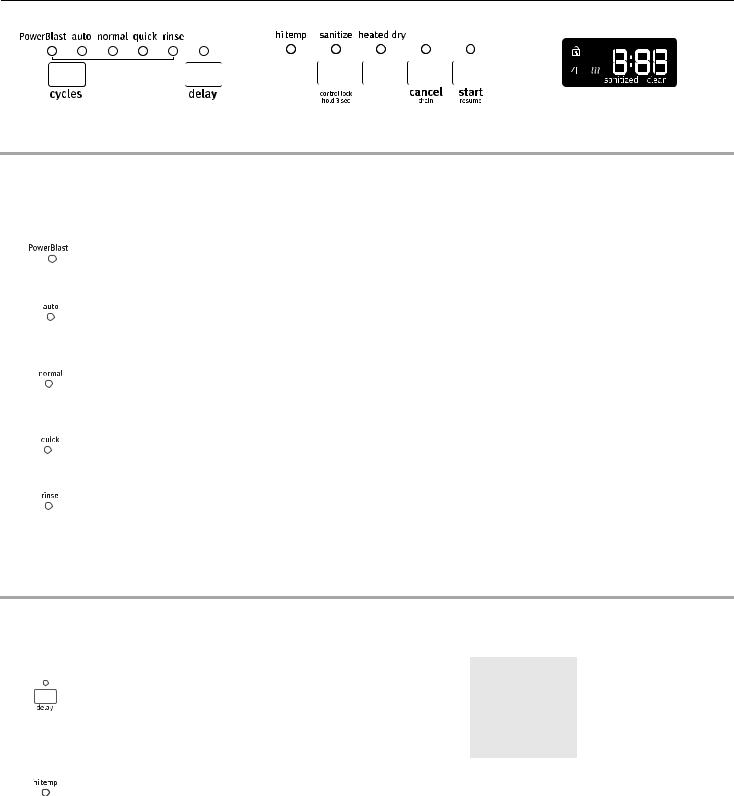
Cycle and Option Descriptions
This information covers several different models. Your dishwasher may not have all of the cycles and options described.
CYCLE SELECTION
CYCLES |
ESTIMATED |
WATER |
|
WASH TIME |
USAGE |
|
DISPLAYED* |
GALLONS |
|
|
(LITERS) |
|
|
|
Targets toughest food soils. Use for hard-to-clean heavily soiled pots, pans, |
3:28 |
9.0 (34.0) |
casseroles, and tableware. |
|
|
® |
|
|
|
|
|
Load and soil sensing cycle. This cycle is optimized to achieve best cleaning with |
2:03 |
4.5 (16.9) |
minimal water and energy for all soil levels. |
|
|
|
|
|
This cycle with only the Heated Dry option selected, and without other options |
1:51 |
3.8 (14.5) |
selected, is recommended to completely wash and dry a full load of normally soiled |
|
|
dishes. The energy usage label is based on this cycle and option combination. |
|
|
|
|
|
For fast results, this cycle will clean light to medium soiled dishes, but use slightly |
:59 |
5.5 (20.9) |
more water and energy. For improved drying, select Heated Dry option. |
|
|
|
|
|
Use for rinsing dishes, glasses, and silverware that will not be washed right away. |
:11 |
1.3 (4.9) |
Do not use detergent. During cycle, the rinse action will repeatedly pause for |
|
|
several seconds. |
|
|
*Adding options will add time to cycle. See options information. Cycle times may increase depending on water temperature, heavy soil condition, dish load size, and options selected.
OPTION SELECTIONS
OPTIONS |
CAN BE |
WHAT IT DOES |
ADDED TIME |
ADDED |
|
SELECTED |
|
TO CYCLE |
WATER |
|
WITH |
|
|
GALLONS |
|
|
|
|
(LITERS) |
|
|
|
|
|
Runs dishwasher at a later time or during off-peak |
Available with |
Delays start of a |
NA |
NA |
electrical hours. Select a wash cycle and options. |
any cycle |
cycle up to |
|
|
Press Delay to cycle through delay time options. |
|
24 hours. |
|
|
Press START/RESUME. Close door firmly. |
|
|
|
|
NOTE: Anytime door is opened (such as, to add a |
|
|
|
|
dish), Start/Resume button must be pressed again to |
|
|
|
|
resume delay countdown. |
|
|
|
|
Raises main wash temperature to improve cleaning |
Auto |
Raises main wash |
:04 to 1:16 |
0-1.2 |
for loads containing tough, baked-on food. |
PowerBlast® |
temperature from |
|
(0-4.5) |
|
Normal |
105°F (41°C) to |
|
|
|
129°F (54°C). |
|
|
|
|
|
|
|
|
7

|
OPTIONS |
|
CAN BE |
WHAT IT DOES |
ADDED TIME |
ADDED |
|
|
|
SELECTED |
|
TO CYCLE |
WATER |
|
|
|
WITH |
|
|
GALLONS |
|
|
|
|
|
|
(LITERS) |
|
|
|
|
|
|
|
|
Sanitizes dishes and glassware in accordance with |
Auto |
Increases main |
:04 to 1:15 |
0-3.0 |
|
|
NSF International NSF/ANSI Standard 184 for |
PowerBlast® |
wash temperature |
|
(0-11.2) |
|
|
Residential Dishwashers. Certified residential |
Normal |
from 105°F (41°C) |
|
|
|
|
dishwashers are not intended for licensed food |
to 145°F (63°C) and |
|
|
||
|
establishments. Only sanitizing cycles have been |
|
final rinse from |
|
|
|
|
designed to meet the requirements of the NSF/ANSI |
|
140°F (60°C) to |
|
|
|
|
184 performance standard for soil removal and for |
|
156°F (69°C). |
|
|
|
|
sanitization efficacy. There is no intention, either |
|
|
|
|
|
|
directly or indirectly, that all cycles on a NSF/ANSI |
|
|
|
|
|
|
184 certified dishwasher meet the NSF/ANSI 184 |
|
|
|
|
|
|
performance standard for soil removal and for |
|
|
|
|
|
|
sanitization efficacy. |
|
|
|
|
|
|
At end of the cycle, the sanitized indicator (or word |
|
|
|
|
|
|
“sanitized” on some models) will glow. If the load did |
|
|
|
|
|
|
not properly sanitize, the indicator will flash at the |
|
|
|
|
|
|
end of the cycle. This can happen if cycle is |
|
|
|
|
|
|
interrupted or if the water does not reach the |
|
|
|
|
|
|
required temperature. The light goes off when you |
|
|
|
|
|
|
open and close the door or press CANCEL. |
|
|
|
|
|
|
Dries dishes with heat. Use option with rinse aid to |
Auto |
Uses heating |
:29 to :46 |
0 |
|
|
provide best drying results. Plastic items are less |
PowerBlast® |
element to speed |
|
|
|
|
likely to deform when loaded in top rack. Turn option |
Normal |
drying times. |
|
|
|
|
off for an air dry. |
|
|
|
|
|
|
|
|
Quick |
|
|
|
|
|
CONTROLS AND CYCLE STATUS |
|
|
|
|
|
|
|
|
|
|
|
CONTROL |
PURPOSE |
COMMENTS |
|
|
|
|
C
A B
Press to start or resume |
If the door is opened during a cycle or power is interrupted, Start/Resume indicator |
a wash cycle. |
flashes. Cycle will not resume until door is closed and Start/Resume is pressed. |
|
NOTE: If Start/Resumebutton is located on top of door, push door firmly closed within |
|
4 seconds of pressing START/RESUME. If door is not closed within 4 seconds, Start |
|
button LED will flash, an audible tone will be heard (on some top control models), and |
|
cycle will not start. |
Press to cancel wash cycle. |
Close door firmly. The dishwasher starts a 3-minute drain (if needed). Let dishwasher |
|
drain completely. |
Control Lock avoids unintended use of dishwasher between cycles, or cycle and option changes during a cycle.
To turn on Lock, press and hold CONTROL LOCK or SANITIZE (depending on model) for 3 seconds. Control Lock light will stay on for a short time, indicating that it is activated and all buttons are disabled. If you press any button while the dishwasher is locked, light flashes 3 times. Dishwasher door can still be opened/closed while controls are locked.
To turn off Lock, press and hold CONTROL LOCK or SANITIZE (depending on model) for 3 seconds. Light turns off.
NOTE: If the model requires you to press and hold Sanitize to lock controls, Control Locked LED (C) will be on or off to indicate whether Control Lock is active or not.
8
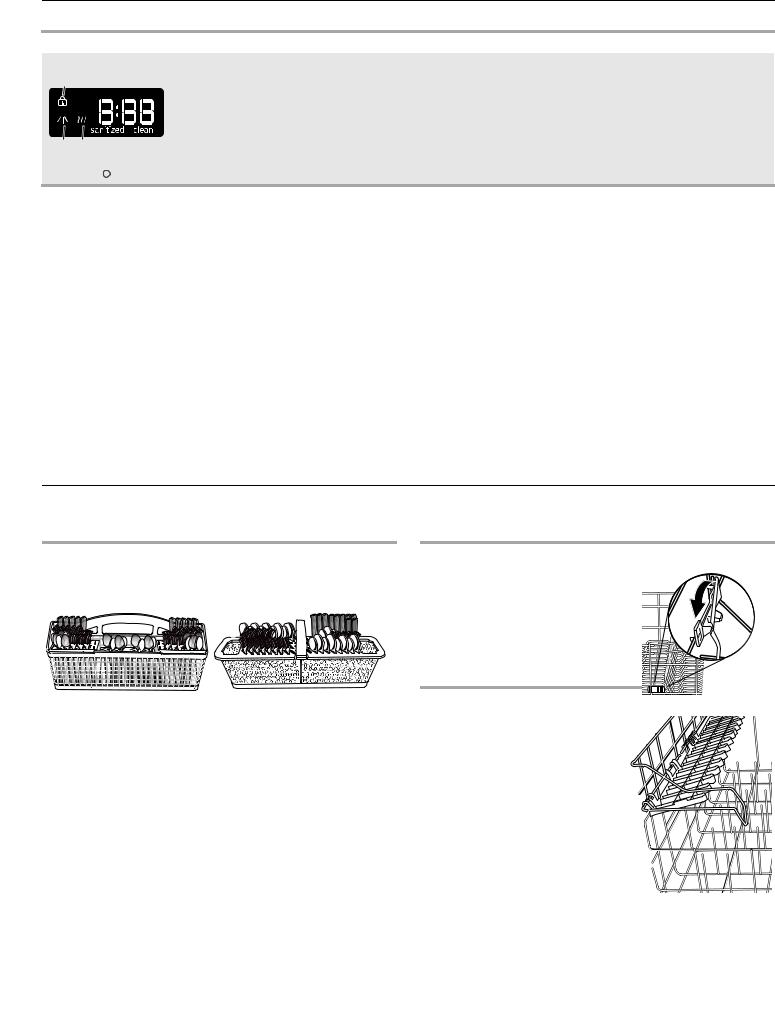
Dishwasher Feedback Section
CONTROL |
PURPOSE |
COMMENTS |
C
A B
To follow the progress of the dishwasher cycle
Depending on the model, progress will be displayed by a fully lit display or by an indicator light on the front panel.
The full lit display will glow for Wash (A), Dry (B), Sanitized or Clean. It will also show the estimated remaining time for the cycle.
The indicator light will glow blue for wash, red for dry, and green for cycle complete.
Canceling A Cycle
1.Open the door slightly to stop the cycle. Wait for the spraying action to stop before completely opening the door.
2.Press CANCEL/DRAIN button once. The Cancel/Drain light will light up.
3.Close the door, and the dishwasher starts a drain cycle (if water remains in bottom of dishwasher). Let the dishwasher drain completely. The Cancel/Drain light turns off after
3 minutes.
Changing A Cycle After Dishwasher Is Started
You can interrupt a cycle and restart the dishwasher from the beginning using the following procedure.
1.Open the door slightly to stop the cycle. Wait for the spraying action to stop, then open the door completely.
2.Check that detergent dispenser cover is still closed. If cover is open, you will need to refill the detergent dispenser before restarting the new cycle.
3.Press CANCEL/DRAIN twice to reset the control.
4.Select new cycles and options.
5.Press START/RESUME.
Adding A Dish After Dishwasher Is Started
1.Check if Add a Dish indicator is lit. (Available on some models. Otherwise, proceed to Step 2.)
2.Open the door slightly to stop the cycle. Wait for the spraying action to stop, then open the door completely.
3.Check whether the detergent dispenser cover is still closed. If it is open, the wash cycle has already started and adding a dish is not recommended.
4.If detergent has not yet been used (detergent dispenser cover is closed), you may add a dish.
5.Press START/RESUME.
Dishwasher Features
Your Maytag dishwasher may have some or all of these features.
Silverware Basket
Use suggested loading patterns, as shown, to better clean the silverware.
10-place loading
Use the slots in the cover to keep the silverware separated for optimum wash.
If the silverware does not fit into the designated slots, slide the cover outward to remove them and mix silverware types to keep them separated.
Load knives down, forks up, and alternate spoons for best cleaning results.
Folding Tines
The folding tines located in the back left corner (lower rack) provide convenient loading space for large, bulky items such as pots, pans, and mixing bowls.
To lower the tines:
Gently push the tines out of each holder toward the center and lay the tines down.
Stack-Rack Shelves
Increase loading flexibility – items such as casserole dishes stay stable while the folding shelf allows you to load smaller items on top.
9
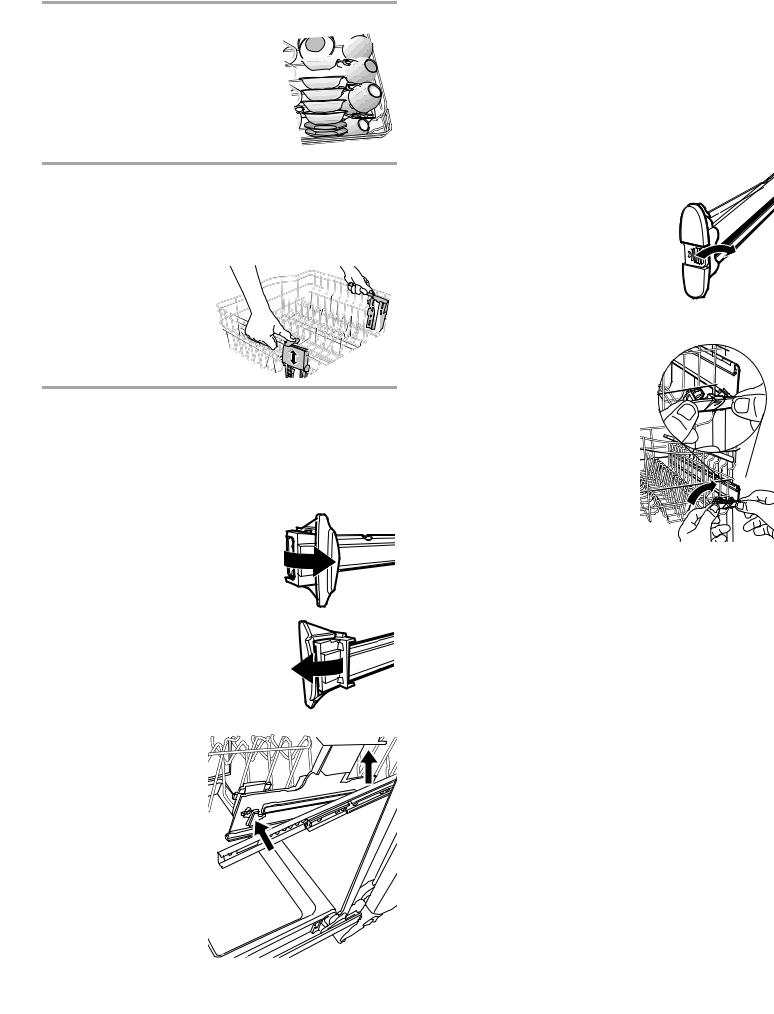
Cup Shelf
Fold down the extra shelf on the left-hand or right-hand side of the top rack to hold 
 additional cups, stemware, or long items
additional cups, stemware, or long items 
 such as utensils and spatulas.
such as utensils and spatulas. 




Adjustable Upper Racks
The Adjustable upper rack can be raised or lowered to accommodate taller plates, platters, pots or pans in the upper or lower racks. Full size dinner plates can be loaded in the upper rack if it is in the lower position.
NOTE: Always unload racks before adjusting.
To raise the rack, press both rack adjusters and lift the rack until it is in the up position and level.
To lower the rack, press both rack adjusters and slide the rack back to its lower position.
Removable Upper Rack
The removable upper rack allows you to wash larger items such as stock pots, roasters, and cookie sheets in the lower level rack.
IMPORTANT: Remove dishes prior to removing the upper rack from the dishwasher.
Style A
To remove the rack:
1. Roll the rack ¹⁄ to ¹⁄ of the way out of the tub.
2. Rotate the rack stops outward.
3.Roll the rack all the way out
of the track and remove from the dishwasher.
To replace the rack:
Reverse the above steps 1-3 to replace the rack into the dishwasher.
Style B
To remove the rack:
1.To gain access to the removable tabs on the tracks/rails, pull the
upper rack forward about halfway out of the tub.
2. On one side, press the tab on the track in and pull the front end of the rack up and out of the track. Then repeat this step on the other side to completely remove the front end of the rack.
3. Remove the rack by pulling the back end out using a forward and upward motion.
To replace the rack:
1.Pull the tracks forward about halfway out of the tub.
2.Along the sides of the racks are round attachment tabs. Align the rack’s back end attachment tabs with the cutout in the track. Push down into place.
3.Pull the tracks completely out and align the rack’s front end attachment tabs with the cutout in the track. Push down into place. You will hear a snap when the front end of the rack is secured into place on each side.
Style C
To remove the rack:
1.To gain access to the track stops, pull the upper rack forward about halfway out of the tub.
2. Press on the edge of the ridged area on the track stop while tipping the track stop toward the center of the dishwasher. This action releases a small retaining tab that locks the track stop to the track (see Track stop - left).
NOTE: It is helpful to use 2 hands. Take
special note of the orientation of the Track stop - left track stops.
3. With the retaining tab released, pull the track stop straight toward the opposite track to remove it.
4. After removing both track stops, gently pull the top rack out of the tracks by rolling it toward you.
5. Replace the track stops by coming |
|
up from under the track and |
|
slipping the track stop into the |
|
lower slot of the track (see Track |
|
stop - right) and rotate the track |
|
stop into place. Then press on the |
|
edge of the ridged area while |
|
pushing the track stop straight |
|
toward the track. This action locks |
Track stop - right |
the retaining tab back into place. |
6.Test the track stop by pulling it
toward the opposite track to ensure that it is locked in place.
To replace the rack:
1.Gently pull the tracks forward in dishwasher until they stop. Remove track stops. (See steps 1-3 above.)
2.Place the back wheels on each side of the rack into the track and roll the rack into the tracks, but do not push the rack all the way into the tub.
3.Insert front rack wheels on each side of the rack into the track.
4.Slide the rack into the dishwasher.
5.Replace the track stops by coming up from under the track and slipping the track stop into the lower slot of the track (see Track stop - right) and rotate the track stop into place. Then press on the edge of the ridged area while pushing the track stop straight toward the track. This action locks the retaining tab back into place.
6.Test the track stop by pulling it toward the opposite track to ensure that it is locked in place.
IMPORTANT: Be sure that the track stops are locked in place and cannot be easily removed. They keep the rack from coming out of the track.
10

Dishwasher Care
CLEANING THE DISHWASHER
Cleaning the exterior |
Drain air gap |
Clean the exterior of the dishwasher with a soft, damp cloth and mild detergent. If the dishwasher has a stainless steel exterior, a stainless steel cleaner is recommended - Stainless Steel Cleaner and Polish Part Number 31464.
Cleaning the interior
Clean the interior of the dishwasher, with a paste of powdered dishwasher detergent and water or use liquid dishwasher detergent on a damp sponge to clean the cooled-down interior.
A white vinegar rinse may remove white spots and film. Vinegar is an acid, and using it too often could damage the dishwasher.
Put 2 cups (500 mL) white vinegar in a glass or dishwasher-safe measuring cup on the bottom rack. Run the dishwasher through a complete washing cycle using an air-dry or an energy-saving dry option. Do not use detergent. Vinegar will mix with the wash water.
Dishwasher Maintenance Procedure
Removal of Hard Water/Filming: Recommended use of a monthly maintenance product such as affresh®† Dishwasher Cleaner Part Number W10282479.
■Load the dishwasher (preferably with dishes affected by filming/hard water).
■Place tablet in main wash compartment of detergent dispenser.
■Select cycle/option best for heavily soiled dishes and start dishwasher.
NOTE: It is recommended to use a premeasured detergent tablet or pack for regular daily use.
If you have a drain air gap, check and clean it if the dishwasher isn't draining well.
To Reduce Risk of Property Damage During Vacation or Extended Time Without Use
■When you will not be using the dishwasher during the summer months, turn off the water and power supply to the dishwasher.
■Make sure the water supply lines are protected against freezing conditions. Ice formations in the supply lines can increase water pressure and cause damage to the dishwasher or home. Damage from freezing is not covered by the warranty.
■When storing the dishwasher in the winter, avoid water damage by having the dishwasher winterized by authorized service personnel.
†® affresh is a registered trademark of Whirlpool, U.S.A.
11

Troubleshooting
First try the solutions suggested here. If you need further assistance or more recommendations that may help you avoid a service call, refer to the warranty page in this manual and scan the code with your mobile device, or visit www.maytag.com/product_help.
In Canada, visit www.maytag.ca.
Contact us by mail with any questions or concerns at the address below:
In the U.S.A.: |
In Canada: |
||
Maytag Brand Home Appliances |
Maytag Brand Home Appliances |
||
Customer eXperience Center |
Customer eXperience Centre |
||
553 Benson Road |
200 – 6750 Century Ave. |
||
Benton Harbor, MI 49022-2692 |
Mississauga, Ontario L5N 0B7 |
||
Please include a daytime phone number in the correspondence. |
|||
|
|
||
PROBLEM |
|
SOLUTION |
|
|
|
|
|
DISHWASHER DOES |
NOTE: It is normal for the dishwasher to repeatedly pause several times during a cycle. |
||
NOT RUN |
If the Start/Resume light is blinking, press START/RESUME and close the door firmly within |
||
|
|
||
|
|
4 seconds. |
|
|
|
Press and hold HI TEMP WASH for 3 seconds to turn the audible tones on or off. |
|
|
|
Be sure the door is closed and latched. |
|
|
|
Be sure you have selected a cycle. See “Cycles and Options Descriptions.” |
|
|
|
Be sure there is power to the dishwasher. A circuit breaker or fuse might have tripped. |
|
|
|
If lights other than Start/Resume blink and the unit will not run, you will need to call for service. |
|
|
|
||
DETERGENT REMAINS IN THE |
Check for dishware such as cookie sheets, cutting boards, or large containers, etc., that may be |
||
DISPENSER OR |
blocking the detergent dispenser from opening properly. |
||
TABLET IS ON BOTTOM |
Be sure the detergent is fresh and lump free. |
||
OF TUB |
|||
Be sure the cycle has been completed (green light is on). If it has not been completed, you will need |
|||
|
|
||
|
|
to resume the cycle by pressing START/RESUME and closing the door within 4 seconds. |
|
|
|
||
CYCLE RUNS TOO LONG |
NOTES: |
||
|
|
■ Efficient dishwashers run longer to save water and energy. Cycle times may increase depending |
|
|
|
on selections. (See “Cycles and Options Descriptions” for estimated cycle times.) |
|
|
|
■ A water heater setting of 120°F (49ºC) is best. The dishwasher will delay longer while heating |
|
|
|
cooler water. |
|
|
|
Try the Quick Wash cycle. |
|
|
|
Run the hot water at a faucet close to the dishwasher before starting the cycle. |
|
|
|
||
DISHWASHER NOT DRYING |
NOTE: Plastic and items with nonstick surfaces are difficult to dry because they have a porous |
||
|
|
surface, which tends to collect water droplets. Towel drying may be necessary. |
|
|
|
Use of rinse aid along with the Heated Dry and Sanitize options will provide the best drying and avoid |
|
|
|
excess moisture in the dishwasher interior. |
|
|
|
Proper loading of items can affect drying. (See specific loading instructions within this guide.) |
|
|
|
Glasses and cups with concave bottoms hold water. This water may spill onto other items when |
|
|
|
unloading. |
|
|
|
■ Unload the bottom rack first. |
|
|
|
■ Place these items on the more slanted side of the rack for improved results. |
|
|
|
||
WILL NOT FILL |
Be sure the water is turned on to the dishwasher. |
||
|
|
Check that the float is free from obstructions. |
|
|
|
Check for suds in the dishwasher. If foam or suds are detected, the dishwasher |
|
|
|
may not operate properly or may not fill with water. |
|
|
|
||
WATER REMAINS IN THE TUB/ |
Be sure the cycle has been completed (the green light is on). If the cycle has not been completed, you |
||
WILL NOT DRAIN |
will need to resume the cycle by pressing START/RESUME and closing the door within 4 seconds. |
||
If dishwasher is connected to a food waste disposer, be sure the knockout plug has been removed from the disposer inlet.
Check for kinks in the drain hose.
Check for food obstructions in the drain or garbage disposer.
Check the house fuse or circuit breaker.
12

PROBLEM |
SOLUTION |
|
|
HARD WATER |
NOTE: Extremely hard water mineral deposits can cause damage to the dishwasher and make it |
(WHITE RESIDUE ON |
difficult to achieve good cleaning. A water softener is strongly recommended if the hardness is |
DISHWASHER INTERIOR OR |
15 grains or more. If a water softener is not installed, the following steps may help: |
GLASSWARE) |
Use a commercial cleaner designed for dishwashers once per month. |
|
|
|
Always use a rinse aid. |
|
Always use a high-quality, fresh detergent. |
|
Use a detergent booster/water softener additive designed for dishwashers. |
|
|
ODORS |
NOTE: If the dishwasher is not used daily, you can run a rinse cycle with the partial load until a full |
|
load is ready to run. |
|
Run a vinegar rinse through the dishwasher by putting 2 cups (500 mL) of white vinegar in an upright |
|
glass measuring cup in the lower rack. Run a normal cycle with the Heated Dry option turned off. Do |
|
not use detergent. |
|
The dishwasher may not be draining properly, see “WATER REMAINS IN THE TUB/WILL NOT DRAIN” |
|
in “Troubleshooting.” |
|
|
NOISY |
NOTES: |
|
■ Surging sounds can occur periodically throughout the cycle while the dishwasher is draining. |
|
■ Normal water valve hissing may be heard periodically. |
|
■ A normal snap sound may be heard when the detergent dispenser opens during the cycle and |
|
when the door is opened at the end of the cycle. |
|
■ Improper installation will affect noise levels. |
|
Be sure the filters are properly installed. |
|
A thumping sound may be heard if items extend beyond the racks and interfere with the wash arms. |
|
Readjust the dishware and resume the cycle. |
|
|
FOOD SOILS REMAIN |
Be sure the dishwasher is loaded correctly. Improper loading can greatly decrease the washing |
ON DISHES |
performance. See “Prepare and Load the Dishwasher” in the “Dishwasher Use” section. |
|
Select the proper cycle and option for the type of soils. PowerBlast® with the Sanitize option can be |
|
used for tougher loads. |
|
Be sure the incoming water temperature is at least 120°F (49ºC). |
|
Use the proper amount of fresh detergent. More detergent is needed for heavier-soiled loads and |
|
hard water conditions. |
|
Scrape food from dishes prior to loading (do not prerinse). |
|
|
DID NOT SANITIZE |
If the sanitized light is blinking, the load is NOT sanitized. The cycle was interrupted in the final rinse, |
|
or the water heater is set too low. Set the water heater to 120ºF (49ºC). |
|
|
DAMAGE TO DISHWARE |
Improper loading can cause dishes to become chipped or damaged. See specific loading instructions |
|
within this guide. |
|
|
BLINKING LIGHTS |
If the Start/Resume light is blinking, press START/RESUME and close the door within 4 seconds. |
|
If the Clean light or any other lights are blinking and the dishwasher will not run, call for service. |
CLOUDY OR SPOTTED DISHWARE (AND HARD WATER SOLUTION)
NOTES:
■Liquid rinse aid is necessary for drying and to reduce spotting.
■Use the correct amount of detergent.
Confirm that the cloudiness is removable by soaking the item in white vinegar for 5 minutes. If the cloudiness disappears, it is due to hard water. Adjust the amount of detergent and rinse aid. See “HARD WATER (WHITE RESIDUE ON DISHWASHER INTERIOR OR GLASSWARE)” in the “Troubleshooting” section. If it does not come clear, it is due to etching (see below).
Be sure the incoming water temperature is set at 120°F (49ºC).
Try using the Hi Temp and Sanitize options.
To remove spotting, run a vinegar rinse through the dishwasher.
■Wash and rinse the affected dishware and load into dishwasher. Remove all silverware and metal items. Put 2 cups (500 mL) of white vinegar in a glass measuring cup in the lower rack. Run a normal cycle with the Heated Dry option turned off. No detergent is needed.
13

PROBLEM |
SOLUTION |
|
|
ETCHING (PERMANENT |
This is an erosion of the surface of the glassware and can be caused by a combination of: water that |
CLOUDINESS) |
is too hot, from using too much detergent with soft water, or by pre-washing. Detergent needs food |
|
soil to act upon. If etching has occurred, the glassware is permanently damaged. To avoid further |
|
etching, adjust the detergent amount to match the water hardness, stop pre-washing, and use water |
|
heating options only when incoming water temperature is below 120°F (49ºC). |
|
|
LEAKING WATER |
Be sure dishwasher has been installed properly and is level. |
|
Suds can cause the dishwasher to overflow. Measure the detergent accurately and use only |
|
detergents designed for use in a dishwasher. Less detergent is needed in soft water. Try another |
|
brand of detergent if sudsing continues. |
|
To avoid rinse aid leaking from the dispenser, be sure the lid is securely attached and avoid overfilling. |
|
|
TUB IS DISCOLORED |
NOTES: |
|
■ High iron content in the water can discolor the tub. |
|
■ Tomato-based foods can discolor the tub or dishware. |
|
A citrus-based cleaner can be used to clean. |
|
|
14

MAYTAG® DISHWASHER LIMITED WARRANTY
ATTACH YOUR RECEIPT HERE. PROOF OF PURCHASE IS REQUIRED TO OBTAIN WARRANTY SERVICE.
Please have the following information available when you call the Customer eXperience Center:
■Name, address and telephone number
■Model number and serial number
■A clear, detailed description of the problem
■Proof of purchase including dealer or retailer name and address
IF YOU NEED SERVICE:
1.Before contacting us to arrange service, please determine whether your product requires repair. Some questions can be addressed without service. Please take a few minutes to review the Troubleshooting or Problem Solver section of the Use and Care Guide, scan the QR code on the right to access additional resources,
or visit https://www.maytag.com/product_help.
2.All warranty service is provided exclusively by our authorized Maytag Service Providers. In the U.S. and Canada, direct all requests for warranty service to:
Maytag Customer eXperience Center
In the U.S.A., call 1-800-688-9900. In Canada, call 1-800-807-6777.
https://www.maytag.com/ product_help
If outside the 50 United States or Canada, contact your authorized Maytag dealer to determine whether another warranty applies.
TEN YEAR LIMITED WARRANTY
WHAT IS COVERED |
WHAT IS NOT COVERED |
FIRST YEAR LIMITED WARRANTY (PARTS AND LABOR)
For one year from the date of purchase, when this major appliance is installed, operated and maintained according to instructions attached to or furnished with the product, Maytag brand of Whirlpool Corporation or Whirlpool Canada, LP (hereafter “Maytag”) will pay for factory specified replacement parts and repair labor to correct defects in materials or workmanship that existed when this major appliance was purchased, or at its sole discretion replace the product. In the event of product replacement, your appliance will be warranted for the remaining term of the original unit's warranty period.
SECOND THROUGH TENTH YEAR LIMITED WARRANTY (CERTAIN COMPONENT PARTS ONLY - LABOR NOT INCLUDED)
In the second through tenth years from the date of original purchase, when this major appliance is installed, operated and maintained according to instructions attached to or furnished with the product, Maytag will pay for factory specified parts for the following components to correct non-cosmetic defects in materials or workmanship in these parts that prevent function of this major appliance and that existed when this major appliance was purchased. This is a limited 10-year warranty on the below named parts only and does not include repair labor.
■Upper and Lower Racks (excludes cup shelves and silverware basket)
■Chopper Blade
■Stainless Steel Tub and Inner Door Liner
YOUR SOLE AND EXCLUSIVE REMEDY UNDER THIS LIMITED WARRANTY SHALL BE PRODUCT REPAIR AS PROVIDED HEREIN. Service must be provided by a Maytag designated service company. This limited warranty is valid only in the United States or Canada and applies only when the major appliance is used in the country in which it was purchased. This limited warranty is effective from the date of original consumer purchase. Proof of original purchase date is required to obtain service under this limited warranty.
1.Commercial, non-residential or multiple-family use, or use inconsistent with published user, operator or installation instructions.
2.In-home Instruction on how to use your product
3.Service to correct improper product maintenance or installation, installation not in accordance with electrical or plumbing codes or correction of household electrical or plumbing (i.e. house wiring, fuses or water inlet hoses).
4.Consumable parts (i.e. light bulbs, batteries, air or water filters, etc.).
5.Defects or damage caused by the use of non-genuine Maytag parts or accessories.
6.Damage from accident, misuse, abuse, fire, floods, acts of God or use with products not approved by Maytag.
7.Repairs to parts or systems to correct product damage or defects caused by unauthorized service, alteration or modification of the appliance.
8.Cosmetic damage including scratches, dents, chips, and other damage to appliance finishes unless such damage results from defects in materials and workmanship and is reported to Maytag within 30 days.
9.Discoloration, rust or oxidation of surfaces resulting from caustic or corrosive environments including but not limited to high salt concentrations, high moisture or humidity or exposure to chemicals.
10.Pick-up or delivery. This product is intended for in-home repair.
11.Travel or transportation expenses for service in remote locations where an authorized Maytag servicer is not available.
12.Removal or reinstallation of inaccessible appliances or built-in fixtures (i.e. trim, decorative panels, flooring, cabinetry, islands, countertops, drywall, etc.) that interfere with servicing, removal or replacement of the product.
13.Service or parts for appliances with original model/serial numbers removed, altered or not easily determined.
The cost of repair or replacement under these excluded circumstances shall be borne by the customer.
DISCLAIMER OF IMPLIED WARRANTIES
IMPLIED WARRANTIES, INCLUDING ANY IMPLIED WARRANTY OF MERCHANTABILITY OR IMPLIED WARRANTY OF FITNESS FOR A PARTICULAR PURPOSE, ARE LIMITED TO ONE YEAR OR THE SHORTEST PERIOD ALLOWED BY LAW. Some states and provinces do not allow limitations on the duration of implied warranties of merchantability or fitness, so this limitation may not apply to you. This warranty gives you specific legal rights, and you also may have other rights that vary from state to state or province to province.
DISCLAIMER OF REPRESENTATIONS OUTSIDE OF WARRANTY
Maytag makes no representations about the quality, durability, or need for service or repair of this major appliance other than the representations contained in this warranty. If you want a longer or more comprehensive warranty than the limited warranty that comes with this major appliance, you should ask Maytag or your retailer about buying an extended warranty.
LIMITATION OF REMEDIES; EXCLUSION OF INCIDENTAL AND CONSEQUENTIAL DAMAGES
YOUR SOLE AND EXCLUSIVE REMEDY UNDER THIS LIMITED WARRANTY SHALL BE PRODUCT REPAIR AS PROVIDED HEREIN. MAYTAG SHALL NOT BE LIABLE FOR INCIDENTAL OR CONSEQUENTIAL DAMAGES. Some states and provinces do not allow the exclusion or limitation of incidental or consequential damages, so these limitations and exclusions may not apply to you. This warranty gives you specific legal rights, and you also may have other rights that vary from state to state or province to province.
11/14
W10599489C |
®/™ © 2016. Used under license in Canada. All rights reserved. |
5/16 |
15
